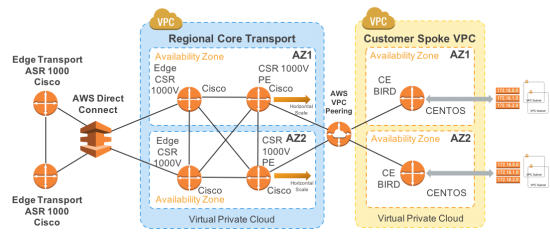Adobe’s Marketing Cloud is a comprehensive set of digital marketing solutions enabling marketers to measure, personalize and optimize digital experiences. As the fastest growing of three business units, reaching its customer base on time became increasingly important as the company continued to grow and expand on new platforms. Adobe Marketing Cloud’s speed to market meant greater agility and mobility to deliver the ultimate customer experience. This required Adobe developers to transition to public clouds using Amazon Web Services (AWS).
Eventually, Adobe had over 700 AWS accounts across multiple regions. A variety of solutions were being used to keep the accounts connected and there wasn’t a centralized network solution. In addition, security teams wanted to ensure Adobe products were following security standards when moving data across public clouds. There became a pressing need to create a global network connecting public clouds to private data centers. With this goal in mind, network engineers began to develop a solution.
Adobe’s Growing Network
Adobe’s infrastructure design is based on edge collection and core processing. This design allows Adobe to deliver personalized content to end users within 300 milliseconds by extending its edge collection closer to the customer base. As Adobe’s customer base continues to grow, it must keep pace with additional edge collection facilities. As the company expands offerings to smaller regions around the world, it will take advantage of cloud edge collections like AWS.
The infrastructure design, called Adobe Multi-Cloud Transport, provides a global MPLS network built on Cisco ASR routers. It connects mixed data center infrastructures together and allows applications to cross end-to-end transparently. Using overlay protocols for end-to-end delivery, allows the data center infrastructure to remain independent and reduces the complexities of more specific technology integrations. The Adobe Multi-Cloud Transport integrates private and public clouds using this overlay protocol:

Using the Cisco ASR and CSR 1000V as MPLS routers simplifies the company’s delivery of AWS VPC’s and allows Adobe to integrate public clouds while maintaining the architecture. The CSR 1000V is the main edge solution when aggregating multiple AWS regions across Adobe’s private backhaul.
Within each AWS region Adobe has multiple accounts requiring collaboration across VPC’s, so traditional VPC peering does not scale. To solve this scaling problem, Adobe implemented a Hub and spoke topology using Cisco’s CSR1000V and AWS Direct Connect:

The adoption of the CSR 1000V seamlessly integrated with Adobe’s environment because it was a virtual platform. This configuration is the same as used with Adobe’s ASR 1000 platforms. The CSR 1000V was deployed in virtual infrastructures exactly how Cisco ASR 1000’s are implemented in physical data centers. CSR 1000V supports Adobe’s global MPLS configuration, routing protocols, BGP’s and ISI’s, GRE tunneling, and the company’s zone-based firewall policies.
Cisco CSR 1000V and AWS provide security and improve performance
Cisco CSR 1000V is a complete multiservice cloud networking platform that provides a transparent expansion into AWS, as well as the familiar user interface of Cisco IOS XE Software. By adopting the Cisco CSR 1000V, organizations can take advantage of existing networking management tools and processes. Cisco CSR 1000V and AWS together provide:
- Secure Inter-VPC Connectivity – Multiregion deployments become simpler with an inter-VPC VPN connectivity. By deploying a Cisco CSR 1000V instance on an Amazon VPC in each region and interconnecting through VPN, you can create and secure a global network topology.
- Branch Office to AWS and Interapplication Security – The Cisco CSR 1000V includes advanced Cisco IOS XE Software security, providing access control lists, MPLS support and a zone-based firewall. It extends enterprise security policies to the AWS Cloud, allowing Adobe to extend network segmentation and apply the same policies and tools across clouds.
- Application performance monitoring and control – Monitor and analyze public cloud security and performance. Control what goes in and out of your environment and extend existing policies across the entire enterprise.
- Branch-office, campus, and data center VPN aggregation – Deploying CSR 1000V enables every branch-office, campus, and data center location to directly access the Amazon VPC securely, without backhauling through an existing data center. This process reduces latency, eliminates expensive private WAN links, and avoids per-VPN-tunnel costs.
Watch the AWS Partner Series webinar, Cisco CSR 1000V: Securely Extend Your Apps to the Cloud, to learn more about how Cisco CSR 1000V and AWS can extend your enterprise network with consistent policies across your hybrid environments.
Try It FREE
Test drive the solution yourself in your own environment with a free 30-day trial on AWS.


CONNECT WITH US